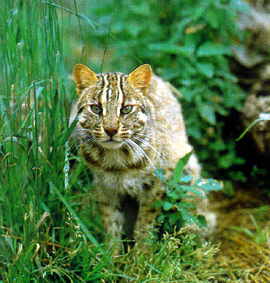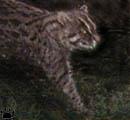Amur Leopard Cat
General Description While the leopard cat is one of the most common small cats in Asia, the Euptilura subspecies of Felis Bengalenses, known as the Amur leopard cat or Far Eastern forest cat, is more rare. Euptiluras or Amur cats are larger than many of the Asian Leopard cat subpecies. They are also different in that their short, dense, usually rosetted coat is more red and gray than other leopard cat subspecies. Euptilura are described as having long legs, a small head, thick tail, heavy bone and muscling.
Distribution The Euptilura's nick name, Amur leopard cat, stems from the fact that the Eupilura is commonly found in the Amur river valley of Russian Far East. Amur River, (uh MOOR,) is a huge river in eastern Siberia. The Amur river system is about 2,744 miles long. The Amur flows east along China's northern border and then turns north into the Khabarovsk Region of Russia. It empties into the northern Tatar Strait, a narrow band of water separating Sakhalin Island from the east coast of Siberia. The valleys of the Amur and its branches cover about 715,000 square miles. The cities of Khabarovsk and Komsomolsk stand on the banks of the Amur. * Click
here for a map of the region. Habitat and Diet The
Amur cat is shy and hard to find. They mostly inhabit the
mountain forests and sometimes the bushy areas. Sightings
have occurred within the isolated hill forests of the
Khanka Lake coastal lowlands in Ussuriland, Russia. They
feed on mice, squirrels, birds, hares, young roes and
other animals, which it can attack.
Amur cat, Novoselskoe, Russia
Reproduction Mating usually occurs in March, producing, on an average, four kittens in May. The male cat helps in raising the young.
Threats The main concern of environmentalists in Ussuriland, the southern part of Russian Far East has been habitat loss. Southern Ussuriland has especially diverse flora and fauna, with a mixture of Siberian and Oriental species. Korean pine (Pinus koraensis), locally known as "cedar", was logged despite its importance as a food source for wildlife. Now most old-growth forests outside nature reserves have been logged, and what remains is relatively well-protected. The most serious problem now is rapid development. Within a decade, local populations of snakes, medicine plants, musk deer (Moschus moschiferus) and bears (Ursus arctos, U. tibetanus) have collapsed. International organizations try to help to protect some species, but they mostly care about large animals.**
*Craig ZumBrunnen,
"Amur River," Discovery Channel School,
original content provided by World Book Online,
http://www.discoveryschool.com/homeworkhelp/ **
Vladimir Dinets,
http://www.hotcity.com/~vladimir/chukotka.htm
Use the pull down menu below.
Contact Holly Erickson
We are near Portland, OR and
(503) 396-5448
This
page last updated
01/01/10
|







